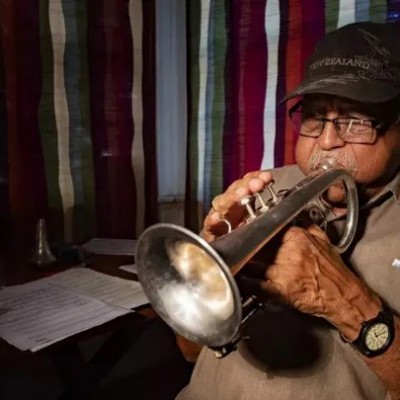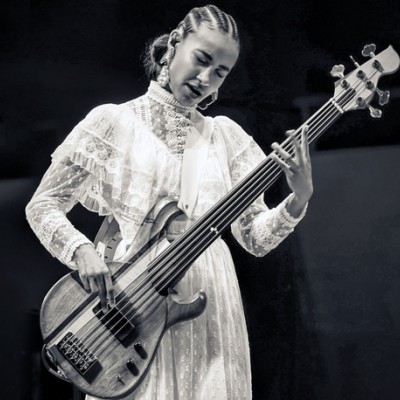Oct 28, 2025 10:47 AM
In Memoriam: Jack DeJohnette, 1942–2025
Jack DeJohnette, a bold and resourceful drummer and NEA Jazz Master who forged a unique vocabulary on the kit over his…

Trumpeters Ingrid Jensen (left), Jason Palmer, Theo Croker, Darren Barrett, Maurice Brown and Marquis Hill perform at Dizzy’s Club Coca-Cola on Sept. 21
(Photo: Brian Zimmerman)The Festival of New Trumpet Music (FONT), founded by Dave Douglas in 2003, has become an extensive, ambitious enterprise. It serves as both a platform for presenting contemporary trumpet sounds—in various musical contexts, not exclusively jazz—and a lens through which to study emerging trends in jazz and brass performance.
The festival’s 2016 edition—which began Sept. 19 and continues through Sept. 25—gracefully met both of those goals with Signatures In Brass, a special performance by Marquis Hill and a cohort of five fellow trumpeters at Dizzy’s Club Coca-Cola on Sept. 21.
With appearances by Ingrid Jensen, Jason Palmer, Theo Croker, Darren Barrett and Maurice Brown, the concert was a brilliant, though hardly all-encompassing, snapshot of the contemporary trumpet scene.
The six trumpeters convened in various configurations—in pairs, in groups of three, as a complete unit—to perform original songs and a commissioned three-movement suite by Hill.
The shifting constellation of players—which sometimes paired trumpeters from opposite stylistic backgrounds—brought forth the best from each trumpeter. As they sparred and conversed, the bandstand radiated with tangible energy, making real the notion that these musicians clearly inspire—and are inspired by— each other.
The group moved at full-throttle from the very start, kicking off with Hill’s breathless, hard-driving bop tune “Black Harvest,” which featured the composer alongside Croker and a rhythm section of Theo Hill on piano, Eric Wheeler on bass and John Davis on drums. In their solos, Croker and Hill skated headlong across the tune’s slick modal chord progression, expertly navigating the rhythmic detours toward a Latin groove.
“Fly By Night,” a spacious, unhurried composition by Brown, down-shifted the mood ever so slightly, but by no means diminished the level of improvisational ingenuity. Barrett, who performed alongside the composer on this r&b-flavored tune, was especially creative in his solo, building tension with a prolonged series of escalating high notes. For his turn in the spotlight, Brown unleashed an extended circular breathing passage in the upper register, his body swaying with the steadfast backbeat of Davis’ drums.
Though their styles differ slightly—Barrett is an adroit bop player of the Clifford Brown school, while Brown is more closely aligned with Roy Hargrove-style funk—their playing coalesced in enchanting ways. During the dual cadenza that brought the song to a close, for example, their tones intertwined to the point of becoming one.
Even more complementary were the styles of Palmer and Jensen, who together performed a version of Palmer’s “Stop, Drop & Roll.” A fearsome swing tune with a knotty, asymmetrical melody, the song allowed both players ample space to construct linear, wandering lines. Jensen was especially acrobatic in her solo, favoring swooping passages that bubbled up from the extremely low register and leaped into the stratospheric high. Across her fast, technical passages, she maintained a focused fluidity.
Possessed of a clean, diamond-like tone, Palmer offered a solo made up of sleek, unusually shaped lines, with passages that skipped from peaks to valleys. During the back-and-forth dialog that signaled the end of the solo section, Palmer and Jensen traded intelligent snippets of thought, giving the illusion that the two trumpeters were finishing each other’s ideas.
Hill’s commissioned piece, “Signatures In Brass,” unfolded in three installments. The first movement—featuring Hill, Croker and Brown—was an ominous odd-metered tune that began with a haunted, bell-tolling pattern in the piano, an effect that was steadily and hypnotically adopted by the trumpets.
Movement II, with Jensen, Barrett and Palmer, was a tender ballad composed of simple, declarative statements, a tone-poem song unfolding in two or three words at a time. Tight harmonies made the sonic portrait feel deep and darkly colored, with nuanced hues emerging from the close juxtaposition of tones.
As could have been expected, Movement III featured all six trumpeters as a single group. Over a headlong swing beat provided solely by the drummer, the trumpeters paired off in good-natured cutting contests—Brown against Hill, Coker against Jensen, Bennett against Palmer—that, at points, achieved the cadence, timbre and vigor or real human conversation.
Hill explained that the inspiration for the commissioned piece was the legacy of Roy Campbell Jr. (1952–2014), a genre-defying trumpeter who helped co-found the festival with Douglas.
Speaking to the festival’s core principle—the presentation of new music for the trumpet—Hill said, “There are so many voices that fall under that umbrella, and I wanted to showcase a few.” With Douglas as a guiding spirit, Hill was able to do just that, giving each voice equal say in a night full of eloquent speakers.
Throughout the weekend, fans of the trumpet will have opportunities to hear even more voices. On Sept. 23, Jason Price will lead the Brooklyn Brass Quintet in a series called Explorations In New Brass Music at the New School Auditorium.
On Sept. 24, trumpeters Taylor Ho Bynum and Wadada Leo Smith will spearhead the Night of Large Ensembles, also at the New School. And on Sept. 25, FONT presents a panel discussion on groundbreaking musician and educator Laurie Fink (1951–2013), which will be followed by a celebratory concert for experimental trumpeter John McNeil, which will feature the honoree alongside Tony Glausi, Jeff Beal and Douglas.

Jack DeJohnette boasted a musical resume that was as long as it was fearsome.
Oct 28, 2025 10:47 AM
Jack DeJohnette, a bold and resourceful drummer and NEA Jazz Master who forged a unique vocabulary on the kit over his…

“Think of all the creative people I’m going to meet and a whole other way of thinking about music and a challenge of singing completely different material than I would have sung otherwise to my highest level in dedication to the moment,” Elling says about his Broadway run.
Sep 9, 2025 1:18 PM
Kurt Elling was back at home in Chicago, grabbing some family time in a late-June window between gigs. Sporting a smile…

Pat Metheny will perform with his Side-Eye III ensemble at Big Ears 2026 in Knoxville, Tennessee, next March.
Sep 9, 2025 12:19 PM
Big Ears has announced the lineup for its 2026 festival, which will take place March 26–29 and include 250…

“[That’s] the thing of the beboppers,” Bradford said. “These guys were important for not only playing that wonderful music, but they knew a sort of social stance, you see?”
Sep 9, 2025 1:07 PM
It was a calm, balmy, near-perfect evening in Westwood, California, not far from UCLA, in the expansive courtyard at…

Esperanza Spalding closed an audacious Chicago Jazz Festival set with “Endangered Species.”
Sep 9, 2025 11:50 AM
The 45th Chicago Jazz Festival kicked off its headline events with two erudite individuals, Esperanza Spalding and…